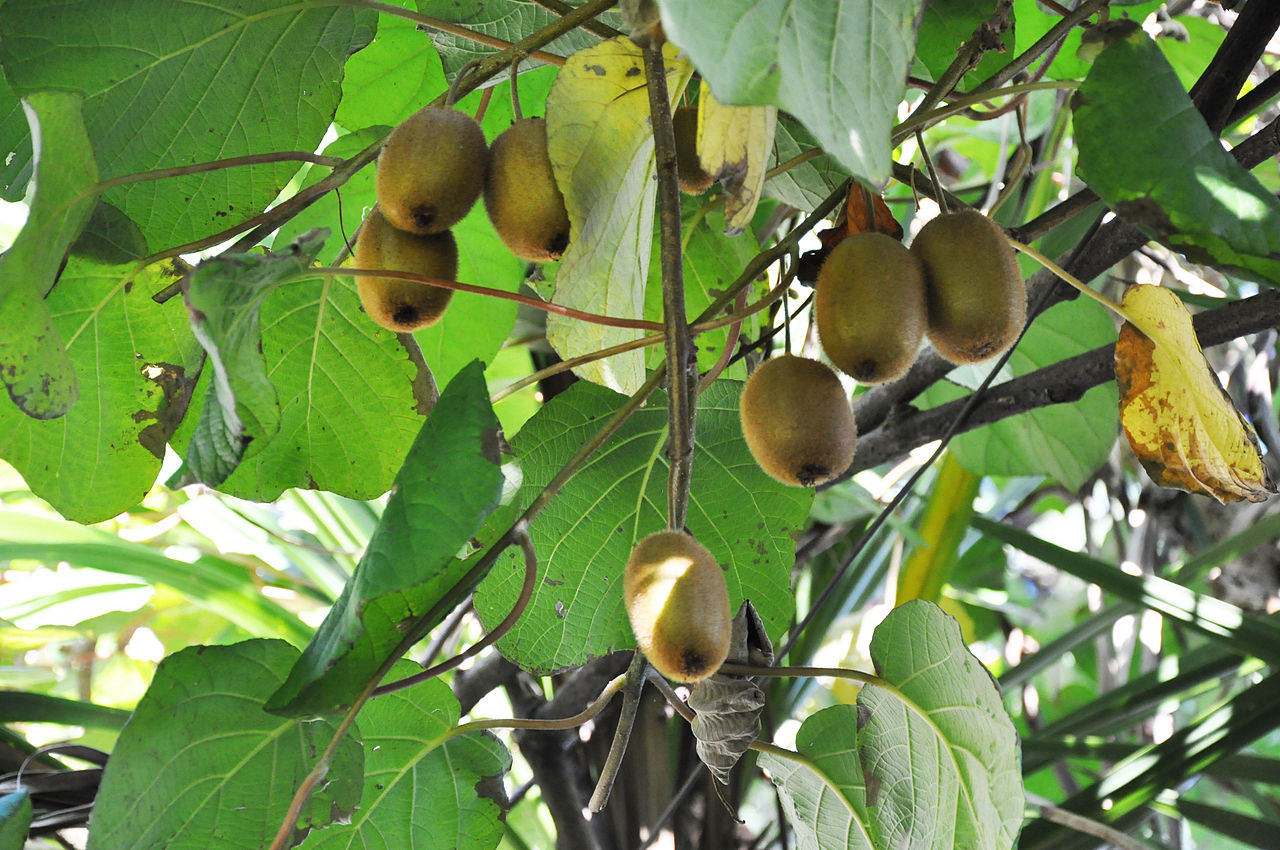Benutzer-Werkzeuge
Actinidia deliciosa (A. Chev.) C.F.Liang & A.R.Ferguson - syn.Actinidia chinensis var. deliciosa (A.Chev.) A.Chev.; Actinidia chinensis var. hispida C.F.Liang - Actinidiaceae
kiwi, Chinese gooseberry, Kiwi, Chinesische Stachelbeere
„Actinidia chinensis var. deliciosa is the widely cultivated kiwifruit. This taxon was recognized as a species under the name A. deliciosa (Liang & Ferguson, Guihaia 4: 181. 1984) by elevating the status of A. latifolia var. deliciosa. Kiwifruit cultivars grown in commercial orchards outside of China were derived from seeds introduced to New Zealand in 1904 (Ferguson & Bollard in Warrington & Weston, Kiwifruit Sci. Managem. 165-246. 1990).“ http://www.efloras.org/florataxon.aspx?flora_id=2&taxon_id=250076893
„The two botanical varieties are: Actinidia deliciosa var. chlorocarpa and Actinidia deliciosa var. deliciosa.
Zhong hua (Chinese gooseberry), jing li (northern pear gooseberry), ruan zao (soft date gooseberry) and mao hua (may be tight- or loose-haired) are the four main cultivars of this species in China. 'Abbott', 'Allison', 'Bruno', 'Hayward', Monty ('Montgomery') and 'Greensill' are the most significant cultivars in New Zealand.“
https://en.wikipedia.org/wiki/Actinidia_deliciosa
„The relative roles of volatile and non-volatile compounds and fruit firmness in the sensory attributes of ripe kiwifruit (Actinidia deliciosa (A Chev) Liang et Ferguson var deliciosa cv Hayward) were investigated. Kiwifruit harvested at different maturities and ripened either immediately after harvest or after storage were assessed individually using various objective and sensory parameters.
As fruit firmness decreased within the eating ripe range, the levels of several volatile esters, pentan-3-one and ethylene production increased. The levels of C6 aldehydes, C6 alcohols and ethanol showed little or no change within this fruit firmness range.
Ethyl esters were the major contributors to total volatiles in ripe, freshly harvested fruit, but ethanol was the most abundant volatile in mature fruit that had been stored at 0° prior to ripening. Ethyl butanoate was the most abundant ester in unstored fruit whereas ethyl acetate was generally the most abundant ester in stored fruit. Stored fruit from the later harvests had higher levels of α- and β-pinene than fresh fruit or immature stored fruit.“
[Relationships between sensory properties and chemical composition of kiwifruit (Actinidia deliciosa)., Paterson, V. J., Macrae, E. A., Young, H., Journal of the Science of Food and Agriculture, Vol.57(2), 1991, 235-251]
„Kiwifruit volatile flavour compounds were evaluated with headspace solid-phase microextraction (SPME) as a sample concentration technique. Gas chromatography–mass spectrometry (GC-MS) was used for qualitative and semi-quantitative analysis after SPME. Components such as heptanal, ethyl hex-3-enoate, 6-methylhept-5-en-2-one, acetic acid, cis/trans-2-nonenal (mixture) and cis/trans-2-decenal (mixture), which were previously found only in kiwifruit juice, were detected by headspace SPME-GC-MS. Other compounds (pent-4-enal, trans,trans-nona-2,4-dienal, 2-nonanone, ethyl octanoate, butyrolactone and 2-propenyl butanoate), which had not been found previously, were identified. Flavour volatiles of kiwifruit were very sensitive to storage time and state of ripeness.“
[Application of headspace solid-phase microextraction to volatile flavour profile development during storage and ripening of kiwifruit., Wan, X. M., Stevenson, R. J., Chen, X. D., Melton, L. D., Food research international, Vol.32(3), 1999, 175-183]
Main volatiles of fresh kiwi fruit puree (concentration in ppm) were 3-methyl-2-butanone (1.1), 3-hydroxy-2-butanone(18.5), (E)-2-hexenal (1.8), ethyl 3-hydroxybutyrate (3.9), phenylethyl alcohol (2.0), α-terpineol (0.9), and geraniol (1.4).
„The olfactometric analysis of the fresh kiwi puree yielded a total of 35 aroma active components. Among them, 3-penten-2-ol, ethyl butanoate, (E)-2-hexenal, 6-methyl-5-hepten-2-one, 1-octen-3-ol, methyl benzoate, and hexyl hexanoate appear to be the major contributors to the aroma in the puree because they were perceived by the three panelists during all nine analyses. (E)-2-Pentenal, hexanal, (E)-2-hexenol, methyl (2-methylthio)acetate, (E,E)-2,6-nonadienal, α-terpineol, and two not positively identified components also have an important contribution to the desirable aroma of this fruit, although they were not perceived in all of the replications.“
[Jordan, Maria J., et al. „Aroma active components in aqueous kiwi fruit essence and kiwi fruit puree by GC-MS and multidimensional GC/GC-O.“ Journal of Agricultural and Food Chemistry 50.19 (2002): 5386-5390]
„Although volatiles have been previously studied in kiwifruit (Actinidia spp.), there has been no co-ordinated study of volatile release and softening through the full edible period. In this report, the two most important commercial cultivars A. deliciosa ‘Hayward’ and A. chinensis ‘Hort16A’ were evaluated for volatiles released at different ripening stages corresponding to their typical commercial shelf life, and compared to the sensory quality assessed by a trained taste panel. Gas chromatography–mass spectrometry data indicated that large amounts of straight-chain aldehydes and esters were the dominant volatiles in the two cultivars. In particular, butanoates, the main fruity esters in both fruit, significantly increased during ripening and an extremely high level of butanoates was found in the over-ripe fruit.“
[Changes in volatile production and sensory quality of kiwifruit during fruit maturation in Actinidia deliciosa ‘Hayward’and A. chinensis ‘Hort16A’., Wang, M. Y., MacRae, E., Wohlers, M., Marsh, K., Postharvest biology and technology, Vol.59(1), 2011, 16-24]
„Typically, 100 g kiwifruits produced 66.3 ± 5.8 mg (1.2 ± 0.1 mg CE) of sugar-free kiwifruit extract (KFE). KFE inhibited both human platelet aggregation and plasma ACE activity in a dose-dependent manner. KFE inhibited platelet aggregation in response to ADP, collagen and arachidonic acid, and inhibitory action was mediated in part by reducing TxA2 synthesis. The IC50 for ADP-induced platelet aggregation was 1.6 ± 0.2 mg/ml (29.0 ± 3.0 μg CE/ml), whereas IC50 for serum ACE was 0.6 ± 0.1 mg/ml (11.0 ± 1.2 μg CE/ml). Consuming 500 mg of KFE (9.0 mg CE) in 10 g margarine inhibited ex vivo platelet aggregation by 12.7%, 2 h after consumption by healthy volunteers (n = 9). All these data indicate that kiwifruit contains very potent antiplatelet and anti-ACE components. Consuming kiwifruits might be beneficial as both preventive and therapeutic regime in cardiovascular disease.“
[Inhibitory effects of kiwifruit extract on human platelet aggregation and plasma angiotensin-converting enzyme activity., Dizdarevic, L.L., Biswas, D., Uddin, M.M., Jørgenesen, A., Falch, E., Bastani, N.E., Duttaroy, A.K., Platelets, Vol.25(8), 2013, 567-575]

fruits, author: Lazaregagnidze CC BY-SA 3.0
Wikimedia Commons
